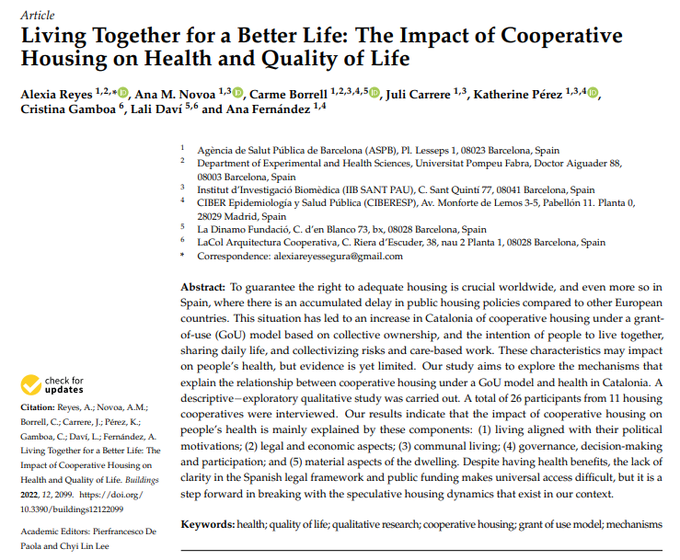Living Together for a Better Life: The Impact of Cooperative Housing on Health and Quality of Life
This study explores the mechanisms that explain the relationship between cooperative housing under a Grant-of-use model and health in Catalonia. The benefits are mainly derived from sharing daily life; collectivizing risks and care work; and through the security provided by the long-term grant-of-use model. When public policies recognize, promote, fund & support these new models, it opens the door to an inclusive & transformative model, with the potential to generate healthier, more sustainable, & fairer communities. In conclusion, coop housing under the GoU model can have a positive impact on people’s health and quality of life.

Abstract: To guarantee the right to adequate housing is crucial worldwide, and even more so in Spain, where there is an accumulated delay in public housing policies compared to other European countries. This situation has led to an increase in Catalonia of cooperative housing under a grant-of-use (GoU) model based on collective ownership, and the intention of people to live together, sharing daily life, and collectivizing risks and care-based work. These characteristics may impact on people’s health, but evidence is yet limited. Our study aims to explore the mechanisms that explain the relationship between cooperative housing under a GoU model and health in Catalonia. A descriptive−exploratory qualitative study was carried out. A total of 26 participants from 11 housing cooperatives were interviewed. Our results indicate that the impact of cooperative housing on people’s health is mainly explained by these components: (1) living aligned with their political motivations; (2) legal and economic aspects; (3) communal living; (4) governance, decision-making and participation; and (5) material aspects of the dwelling. Despite having health benefits, the lack of clarity in the Spanish legal framework and public funding makes universal access difficult, but it is a step forward in breaking with the speculative housing dynamics that exist in our context.
Alexia Reyes 1,2,* , Ana M. Novoa 1,3 , Carme Borrell 1,2,3,4,5 , Juli Carrere 1,3, Katherine Pérez 1,3,4, Cristina Gamboa 6, Lali Daví 5,6 and Ana Fernández 1,4
1 Agència de Salut Pública de Barcelona (ASPB), Pl. Lesseps 1, 08023 Barcelona, Spain
2 Department of Experimental and Health Sciences, Universitat Pompeu Fabra, Doctor Aiguader 88, 08003 Barcelona, Spain
3 Institut d’Investigació Biomèdica (IIB SANT PAU), C. Sant Quintí 77, 08041 Barcelona, Spain
4 CIBER Epidemiología y Salud Pública (CIBERESP), Av. Monforte de Lemos 3-5, Pabellón 11. Planta 0, 28029 Madrid, Spain
5 La Dinamo Fundació, C. d’en Blanco 73, bx, 08028 Barcelona, Spain
6 LaCol Arquitectura Cooperativa, C. Riera d’Escuder, 38, nau 2 Planta 1, 08028 Barcelona, Spain
* Correspondence: alexiareyessegura@gmail.com
Read the full study here.

